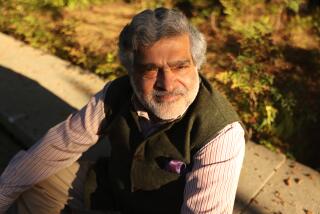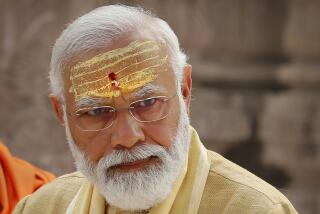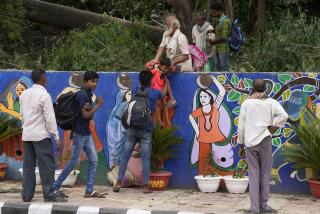COLUMN ONE : India Blurs Gandhi’s Message : Politicians publicly honor the Mahatma’s name and image, but they scorn his ideas. Just one remote village struggles to keep his vision of society alive.
- Share via
SEVAGRAM, India — Freshly scrubbed and neatly turned out in blue dresses and red ties, the girls of Holy Cross English High School came on a pilgrimage to this small country hamlet where the “Father of the Nation” once lived.
The pupils, 11 and 12, quietly entered the modest hut of adobe, bamboo and red roofing tiles where Mohandas Karamchand Gandhi slept on a thin mattress on the floor. They viewed the wooden septic tank he cleaned with his own hands. In a showcase, they saw Gandhi’s spittoon.
When the tour was over, Naveeda Ibban asked her pupils whether they would be willing to give up their clothes and other belongings to live like the man Indians honor as the Mahatma--”Great Soul.”
“Yes, mistress!” the girls said.
Would they skip their favorite foods? Pass up television shows they like?
Again, the girls shouted “yes!” throwing their hands into the air.
Surrounded by such youthful idealism, the teacher from the private school 50 miles from Sevagram could not suppress a skeptical smile.
“Actually,” Ibban said, “we really remember Gandhi-ji just once a year, on Shaheed Divas,” or Martyrdom Day, the anniversary of his Jan. 30, 1948, assassination.
That is true not only for schoolchildren from Amravati. These days, in the land of his birth, the Mahatma is canonized, idolized and set on a lofty pedestal.
But that is not the same as being listened to.
Ironically, as Indian officialdom promotes the Gandhi cult, it also oversees the widespread neglect of many of the causes the “Great Soul” lived, worked and fought for.
In one typical example of the honors paid to Gandhi rather than to his message, the grinning, nearly toothless countenance of the 20th Century’s most famous ascetic graces the 500-rupee bill, India’s largest bank note.
That is one portrait of Gandhi that hundreds of millions of India’s most destitute, the very people the Mahatma fought hardest for, cannot hope to hold in their hands.
If Gandhi could see India today, “he would commit suicide,” said Suresh Pandit, 63, a retired teacher in Rajasthan active in grass-roots literacy campaigns.
Forty-seven years after Gandhi’s murder at age 78 by a Hindu extremist armed with a revolver, government workers routinely keep his portrait garlanded with marigolds above their desks. When politicians make speeches about national unity, nonviolence or the need to prevent differing religions from dividing people--all leitmotifs of Gandhi’s life--they often quote him.
And, when the ruling but now beleaguered Congress (I) Party needs to drum up votes, especially among minorities and the very poor, it brandishes the name and image of Gandhi, who once served as Congress president and who dominated its politics for nearly three decades.
But simultaneously, in the view of Gandhians, “what the people at the top are doing to the country is 100% against what Gandhi-ji would have wanted,” one disciple charged.
Kanakmal Gandhi, 60, no relation to the Mahatma, is an accountant who works as the live-in director of Sevagram.
Founded by Gandhi as a model village in India’s geographic heart, the one-acre site has been turned into a shrine and study center to keep the flickering flame of Gandhi’s message alive.
But that is proving tougher than ever. These days, the $32,000 endowment allotted by the New Delhi-based Gandhi Memorial Fund is no longer enough to pay the salaries of Sevagram’s 40 employees and the rising cost of bamboo and other building materials.
Last year, as a result of an appeal, an additional $160,000 was raised.
“Somehow, we’re managing,” Kanakmal Gandhi assured a recent visitor. “We’re not as hopeless as the government.”
For India, failing to live up to Gandhi’s hopes and vision was, in retrospect, inevitable. After all, for this singular man, the ideal form of industry was the hand-powered spinning wheel, the charkha. The life he chose was one of labor, moral engagement and, later in life, sexual chastity.
For Gandhi, one of the best forms of medicine was a yogurt enema, and in his 70s he was still sleeping in a bed with naked girls to test his ability to withstand carnal temptation.
Even while he was alive, the barons of the Indian National Congress, the embryo of the independent Indian state, felt free to ignore his often lonely and eccentric point of view.
As one example, Gandhi advocated the spinning wheel so Indians could make their own homespun cloth, or khadi , to replace manufactured imports from England. At the time, that made cold political sense.
But Gandhi, who had a Luddite loathing of modern technology, went much further, seeing spinning as the foundation of the new economic and communal order that he founded Sevagram to help bring about. Many Indians demurred.
India’s first prime minister, Jawaharlal Nehru, publicly rejected the economic notions of the Congress elder he affectionately referred to as “Bapu”--beloved father--as “a throwback to the pre-industrial age.”
Nehru’s dream won out: that of a strong, industrialized and self-sufficient India, run with the precision of Soviet-style five-year plans.
Nearly four years ago, Nehru’s heirs changed India’s economic direction.
Now there is more room for the dog-eat-dog competition of the market, for economic winners and losers, for foreign control of companies. The rich, in getting richer, are supposed to pull the impoverished up by their sandal thongs.
The net result has been to take the land of Gandhi even further away from his ideal.
That is despite--or perhaps because of--a landslide of contemporary iconography, including Richard Attenborough’s 1983 Oscar-winning “Gandhi,” advertised as the celluloid saga of the “Man of the Century” and with Ben Kingsley, like Gandhi a native of Gujarat state, in the title role.
The trouble with such laudatory works, insisted one of Gandhi’s 14 grandchildren, is that they transform their subject into a cuddly teddy bear of a saint and omit his indomitable, combative and often prickly spirit.
In truth, Gandhi was “rather like an Old Testament prophet most of the time,” recalled grandson Ramchandra Gandhi, 57, a writer and itinerant professor. “He was severe. With himself. With everybody.”
Historians of the Indian independence movement, such as Bipin Chandra, say Gandhi’s greatest achievement was the devising of spectacular yet nonviolent ways to mobilize masses of ordinary Indians, usually poor and illiterate, to challenge the greatest imperial power in the world.
In 1921, Gandhi advocated homespun cloth and a boycott of British-manufactured fabrics to strike at the imperialists’ purses.
Across India, bonfires of foreign-made garments were organized.
In 1930, to defy the Salt Law, which made salt an imperial monopoly and a vital source of excise revenue, Gandhi walked 200 miles to the Arabian Sea and picked up a handful of salt, tax free, on the beach. He and 100,000 other Indians who broke the Salt Law were arrested.
Today, many of India’s social problems remain urgent--more than 360 million people live below the official poverty line, more than 430 million cannot read or write, and half the population of 900 million have no clean drinking water.
So where are today’s Gandhis and Gandhians?
“They (India’s leaders) despise Gandhi and are afraid of him,” charged Rajiv Vora, an associate of the New Delhi-based Gandhi Peace Foundation, one of about 2,000 mostly small, private organizations still quixotically struggling to put Gandhi’s ideas into practice.
“They have made him an apostle of nonviolence, and that alone,” Vora said scornfully of India’s ruling elite. “But Gandhi’s life only had meaning as a struggle against the injustice and indignity of an inherently violent, decadent modern civilization.”
Politicians by the hundreds still wear khadi in imitation of Gandhi and the people of the pre-independence “freedom struggle.”
But ordinary Indians are quite capable of seeing through the homespun to judge whether the people clad in it are worthy of the Mahatma.
Outside the entry to the Lok Sabha, India’s lower house of Parliament, a great gilded statue of Gandhi, seated like a Buddha, was dedicated two years ago.
“Nowadays, Gandhi-ji is the only honest man in Parliament,” a building guard commented.
Over the decades, Gandhi’s ideas changed so frequently that he admitted that he often contradicted himself.
But in the broadest terms, the Indian patriot and activist, who was educated in England as a barrister, sought swaraj , or “self-rule,” a mix of national freedom, self-reliance and social justice.
When, attired in a loincloth and accompanied by a goat to provide his daily dose of milk, Gandhi returned to England by steamer in 1930 for talks about the future of Britain’s Indian possessions, one reporter asked him what he thought of modern civilization.
“That would be a good idea,” the Mahatma quipped.
India’s current leaders, bent on catching up with the rest of the world, would not repeat Gandhi’s thought-provoking jest.
Instead, Prime Minister P. V. Narasimha Rao and his ministers want more, not less, imported technology and capital, more electrical generating capacity and computers, more telecommunications infrastructure.
“What everybody knows and no one will admit is that today there is no political party of any influence in the country which has a recognizably Gandhian manifesto,” contended M. Madhava Prasad, a journalist with the Madras-based daily the Hindu.
Many Indians believe that their country was right to turn its back on the social and economic visions of Gandhi, who was born Oct. 2, 1869, in the Arabian Sea town of Porbandar, the last of the six offspring of a senior official in the court of the local prince.
“If his ‘legal heir,’ Nehru, had followed his economic policies, India would have remained a country without any heavy industry,” Delhi resident Ansar Harvani wrote in a letter to a local newspaper. “If Winston Churchill had accepted Gandhi’s advice to resist Hitler and Mussolini through nonviolence, the world would have been doomed to the Dark Ages.”
Similarly, Gandhi’s gentle tolerance is nowhere to be seen in what human rights activists denounce as India’s brutal campaign of repression, allegedly including torture and murder, to wipe out the violent Kashmiri secessionist movement.
And, since the death of this apostle of nonviolence, India has fought in four wars, and in 1974 exploded a nuclear bomb.
At Sevagram, the very different future that the Mahatma envisioned for India can still be conjured from the huts, carefully raked gravel prayer ground and lovingly preserved curios.
Each year, an average of 100,000 tourists, Indian and foreign, visit the site near the small city of Wardha.
At Sevagram--the name means “Village of Service”--Gandhi tried to create a showcase to serve as an example and inspiration to the rural poor. A house had to be built for no more than 500 rupees (today, about $16) of locally available materials, he decreed.
Just as Gandhi wanted the spinning wheel to be the locus of a new Indian economy, the village was to be the country’s social heart. From the rice paddies of Tamil-speaking lands to the hills around Darjeeling planted with tea, the countryside was, after all, where 86% of India’s population was living, most often in ignorance and crushing want.
To better the lot of India’s rural poor, Gandhi withdrew from direct involvement in the politics of the Congress and founded the “laboratory” at Sevagram.
One June night in 1936, aged 67 and weakened by bouts of high blood pressure, Gandhi walked five miles to the backward village of Segaon (later rebaptized Sevagram) and was soaked to the skin by the season’s first monsoon.
“It was as if God had, through the storm, given him a glimpse of the hardships which he would have to undergo,” one disciple wrote.
Gandhi’s dream was for each village to become self-sufficient so that it could educate its children, grow enough food to sustain its people and make its own clothing, edible oil, paper and toothbrushes from twigs of the neem tree.
At Sevagram, Gandhi, his wife, Kasturba, and his followers tried to serve as personal examples, digging latrines and retrieving the excrement to serve as fertilizer.
Most of the 639 original inhabitants were “untouchables,” members of the lowest and most reviled stratum in Hindu society.
With limited success, Gandhi sought to remove the curse from these people he insisted on calling “Harijan”--”Children of God.”
Sevagram was Gandhi’s retreat for more than a decade. But paradoxically, his charisma and renown seem to have guaranteed the experiment’s failure.
He meant it to be a functioning, model rural community. But his followers came by bullock cart over rutted roads and turned Sevagram into an ashram, a place where disciples could live at the feet of their guru.
His village, Gandhi groused, turned into “some kind of shamboomela (human carnival), consisting of all types of curious and abnormal persons who would ordinarily be regarded as ‘cranks’ in society.”
Most damning for the Mahatma’s plan, though, was Sevagram’s failure as an economic prototype. The ashram, which built beehives and introduced the growing of sugar cane and papayas so villagers could improve their diet, was subsidized by a wealthy benefactor.
Expenditures went beyond what unaided villagers could match.
“What I do is for the poor,” Gandhi wrote in frustration in 1941, “but today I am unable to prove it in Sevagram.”
His dream for his country’s rural life may have been stillborn, but Gandhi’s influence and his tactics of nonviolent protest carried far beyond India.
“If you seek his effects, it’s in Martin Luther King, it’s in Lech Walesa,” said historian Chandra.
But in post-independence India, Gandhi “became irrelevant,” Chandra contended. “On the question of nation-building, he had not much to say.”
Every so often, government officials, even prime ministers, come to Sevagram to gaze at the huts where Gandhi and his followers lived, and to seek inspiration. Kanakmal Gandhi recalled one visit by Rajiv Gandhi, the prime minister and grandson of Nehru who was no relation to Mohandas Gandhi, that succinctly expressed the lure and limits of the Mahatma’s ideal.
The handsome, urbane Rajiv (who, like Mahatma Gandhi, was to fall prey to an assassin) whimsically fingered the shirt of khadi he had donned at Sevagram and pondered what it and the rest of the Mahatma’s legacy symbolized.
“There are two worlds,” he said finally. “I don’t know which is good.”
More to Read
Sign up for Essential California
The most important California stories and recommendations in your inbox every morning.
You may occasionally receive promotional content from the Los Angeles Times.













